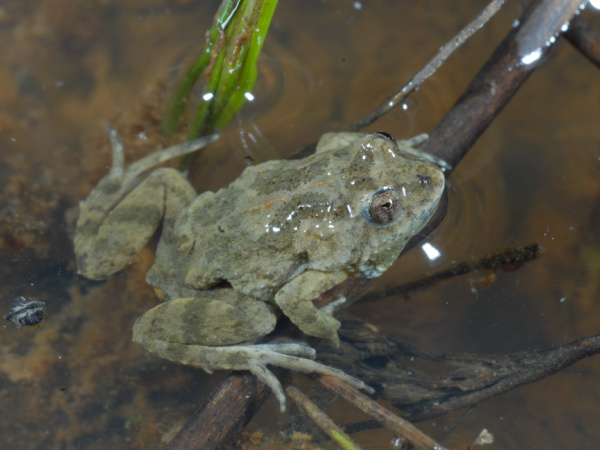Sustainability
- Home
- Locations
- What you can do
- LiFE Framework
- Sustainable Development Goals
- About us
- Grants
- Events
- Contact us
Now searching for:
The Sloane’s Froglet (Crinia sloanei) is a small, ground-dwelling frog, around 15 to 20 mm in size; making it about the size of your thumb’s fingernail.
 These froglets have greyish-green skin, covered with brown patches and a few small orange spots on top. Because they are so small, they can be hard to spot, especially since they will quickly hide when they are startled or feel threatened. The best way to identify them is by the call they make, which is described as a short and metallic
These froglets have greyish-green skin, covered with brown patches and a few small orange spots on top. Because they are so small, they can be hard to spot, especially since they will quickly hide when they are startled or feel threatened. The best way to identify them is by the call they make, which is described as a short and metallic chick, chick, chick
sound. In Winter, they will call throughout the day and night, though their preferred time to do so is after heavy rainfall, where they will sing whilst floating on top of pools of water.
Populations of Sloane’s Froglets are restricted to the floodplains of the Murray Darling-Basin, such as the riparian zone along the Murray River. This includes locations in Thurgoona, Howlong, Corowa, and a small remnant population in Tocumwal.
The remaining, suitable habitat for these frogs usually occurs on small and rural land holdings, making their survival reliant on sympathetic management from private landholders, Charles Sturt University being an example. Because Charles Sturt is located in the middle of the Albury suburb of Thurgoona, it has coverage over critical Sloane’s Froglet habitat, making it an important managing body for their conservation. The construction and maintenance of the David Mitchell Wetland at Charles Sturt is one such endeavour that is important to the viability and persistence of this species, hosting one of the largest froglet populations in the area.
Despite such efforts, this frog species has suffered a severe reduction in population size over the last few decades, experiencing a greater decline than other frog species in the same geographical area. This signifies the need for more conservation work to be undertaken
Sloane’s Froglets utilise both natural and artificial wetlands, whether they are small or large. This includes farm dams, terrain depressions, wetlands, irrigation channels, roadside drains, billabongs, flooded grasslands and gilgais. Habitat connection between breeding and refuge sites is important, as inland Australia’s extremely variable climate means that for Sloane’s to survive and reproduce, they must move across the landscape when it is wet.
This species prefers wetlands containing riparian and aquatic vegetation, where they will be found in waterbodies containing grasses or reeds of medium height, with stems of a small diameter. Favoured plants include the Common spikerush (Eleocharis acuta), Common couch (Cynodon dactylon), Water couch (Paspalum distichum) and Carex species, specifically in the Albury area.
While these froglets can be found in a variety of waterbodies, they do require shallow ponds to be adjoining or nearby as they cannot breed without them. This is because females need to directly lay their eggs onto the partially submerged vegetation that occupy such shallows. This is different to most other frog species that lay free-floating eggs. When the eggs of the froglets then hatch into tadpoles, this same vegetation will provide them with protection from predators, and a place to forage.